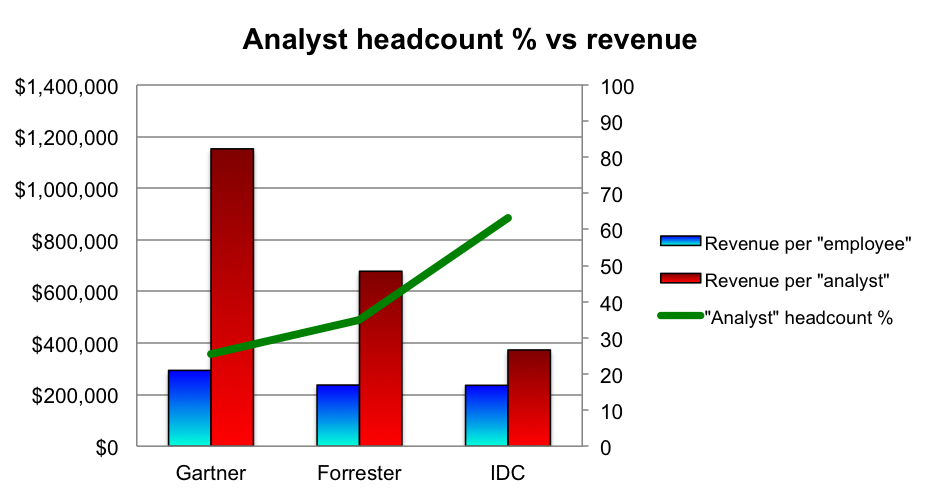This post was originally posted by Dave Noble / IntelligenAR (LinkedIn, @IntelligenAR) on his blog.

Not all IT research is about numbers, but the IT analyst business definitely is. It’s a business after all, and if you don’t make the numbers, you don’t have a business. But what’s interesting is how many different ways there are to make the numbers stack up.
It’s somewhat ironic that while IT analyst firms often rely on public – and private – disclosure of information from both vendors and end-user organisations to make their prognostications, they often don’t like to reveal too much about their own businesses. The big public firms, Gartner & Forrester, disclose good detail about their revenues to meet their statutory requirements, and perhaps a little more, while the private firms tend to be fairly vague.
As a former analyst, I’ve always been intrigued about the insights you can gain by breaking down the numbers. Topline and bottom line figures tell you one thing, but there’s often a more interesting story when you dig a bit deeper – you can see this in my recent post analysing the 2012 financial results for Gartner & Forrester.
I’ve long considered analyst headcount a good indicator of the health of analyst firm. If the headcount is growing, then that’s a reasonable sign that the business is also growing – or has good prospects of growth. Analysts are a product, and typically you don’t hire more of them if the ones you’ve already got aren’t selling.
But it’s not as simple as that. If you can increase revenue without adding analyst headcount ie adding costs, then you’re going to increase the profit margin, which is also a positive indicator. So you need to look at the relationship between analyst headcount, total headcount and revenue to get a better idea of how a firm is performing.
This is where it gets tricky. Not all of these data points are available for all firms, nor are they necessarily comparable. But by poking around the websites of a few of the leading firms and asking questions of their PR folks, I’ve come up with some insights.
Analyst headcounts
For simplicity’s sake, I’m going to use the term “analyst” a little loosely because of the different way that each firm categorises their staff, combining analysts & consultants, because these roles are sometimes shared.
According to Gartner’s website, it has 902 analysts and 500 consultants (total 1,402), an increase of just under 10% from a year earlier, while Forrester employs 432 “research professionals”, a decline of 4% from last year. IDC told me it employs 1,075 analysts, which is higher than the 1,000 stated on its website, although that latter figure has been unchanged for some time.
Ovum advised me that it currently employs 102 analysts and consultants, which is lower than I’d estimated from the analyst bios listed on its website, but those include management. This figure seems largely unchanged from a year ago. Frost & Sullivan confirmed that it employs 1,800 analysts and consultants worldwide, and while this figure seems relatively unchanged, it is unclear how many of these are focused primarily on IT & communications, as is the case for the other firms.
Looking at analysts as a percentage of total employees, Gartner has the lowest ratio – just over 25% – while IDC has the highest, at 63%. Forrester – at 35% – and Ovum – 55% – sit in between these two extremes, and all appear to have drifted downwards slightly in the past couple of years. Of course, these firms have quite different business models, research services, analyst types and client bases, so it is not unusual that the ratios should vary, but it is interesting how starkly different they are.
Unfortunately, we don’t have accurate data for sales headcount for these firms (except Ovum, which is about 25% of its total), but we do know that Gartner has invested heavily in its salesforce over recent years, particularly in Asia/Pacific, but elsewhere as well. Forrester and IDC have also increased their sales hires in the past year, evidenced by total headcount growing at a greater rate than analyst headcount.
Mapping headcount to revenue
The headcount figures become more interesting when we map them against revenues. Forrester and IDC have similar revenue per employee figures – about $US236,000 – but Gartner’s is about 25% higher, just under $US300,000.
 The differences become even more dramatic when we compare revenue per “analyst.” Gartner is generating more than $1.1 million per analyst, some 70% higher than Forrester, and more than 200% higher than IDC! Granted, the different business models don’t make this an apples-for-apples comparison, but the deltas are large enough to demonstrate the point.
The differences become even more dramatic when we compare revenue per “analyst.” Gartner is generating more than $1.1 million per analyst, some 70% higher than Forrester, and more than 200% higher than IDC! Granted, the different business models don’t make this an apples-for-apples comparison, but the deltas are large enough to demonstrate the point.
So what does this tell us? Certainly, Gartner has optimised its sales-to-analyst ratio in recent years, but can it still make gains from pushing this approach further? At what point does reducing the analyst percentage of headcount start to have a negative impact?
Forrester blamed poor sales execution for its weak financial performance last year, and has indicated a greater focus on sales to turn the business around. But does it need to match Gartner to make that happen? Forrester is about one-fifth the size of Gartner, so does scale change the equation?
IDC obviously has a different client base to these two firms, and the analyst workloads are quite different, but can it benefit from adopting this approach, driving analyst percentages down and sales ratios up to increase revenues & margins?
And what does this mean for other, smaller firms, where the sales ratios tend to be lower? Can they learn and benefit from Gartner’s approach?
On the surface, this doesn’t look like a good trend for the analyst business, from an AR perspective. But on deeper assessment, fewer analysts with greater impact & influence are much easier to engage with than lots of analysts with less impact. In other words, simply increasing analyst headcount is probably less effective than improving the penetration of existing analysts by putting more sales resources behind them.
This is one of those areas where I don’t have all the answers, but I find the questions intriguing. What do you think? How important are these ratios to the performance of an analyst firm, to the health of the analyst business overall, to the execution of a vendor AR program? What else can we learn from this analysis?
Cheers,
Dave

Dave
Wow. Thanks for putting this together. It is so critical to understand how these organizations work to successfully work with them. I’m staggered by the Gartner 1.1M per analyst stat. It also justifies why Gartner takes better care of their analysts then others; as do their low attrition rates.
Thanks again for the analysis. You are one of the few doing it.
Beth
Hi Beth,
Thanks for the feedback & glad it was of interest. Sometimes I think it’s a little AR-geeky, but understanding what makes these firms tick is really important to engagement strategies – if only I had more data to play with!!
i do this sort of thing from time to time – you might want to follow my blog http://intelligenar.wordpress.com if this sort of analysis is of interest.
cheers,
Dave
Hi Dave,
Thanks for this analysis. But do you think this stat is enough to engage Gartner instead of Forrester or Ovum? What other factors should I consider before engaging one or more of them. Is it also advisable to engage more than one analyst per time? I will greatly appreciate your response
Cheers
Mike
Hi Mike,
I’d never recommend using just one factor as a reason to engage with an analyst, not would I recommend only engaging with one analyst firm. There are many factors you should take into account – influence, domain knowledge, accessibility, business model, coverage areas etc. It’s a bit too complex to dal with in a short response, but I have written a couple of blog posts on it – Analyst targeting isn’t evil, it’s just segmentation and Inside the black art of analyst targeting & tiering. You’ll find them on my blog at http://intelligenar.wordpress.com
Hope that helps.
cheers,
Dave
Thanks Dave
Mike,
I target analysts based on my objectives (see the AR Compass post here http://iiar.wpcomstaging.com/2013/05/10/iiar-best-practice-webinar-the-ar-compass/ ) and there’s also a great paper on tiering by Susan Galer, see there > http://iiar.wpcomstaging.com/2010/03/18/latest-iiar-white-paper-a-new-foundational-approach-to-analyst-tiering/
Thank you Ludovic